In this article, we will discuss some typical cases and problems based on the concept of alligations and mixtures.
Type 1: Taking out a part of the solution and replacing it.
Example 1: A vessel is filled with liquid, 3 parts of which are water, and 5 parts are syrup. How much of the mixture must be drawn off and replaced with water so that the mixture may be half water and half syrup?
(1) 1/3
(2) 1/4
(3) 1/5
(4) 1/7
(SSC Delhi Police Sub-Inspector (SI) Exam. 19.08.2012)
Solution:(3)
Let the total liquid = 8 parts
Let ussay that ‘x’ litresare replaced.
In ‘x’ litre, part of water will be ![]()
Part of syrup will be =>![]()
This x litre of mixture is replaced by x litres of water.
So net water will be =>
And net syrup =>![]()
Their ratio should be 1: 1
So

Alternate Method:
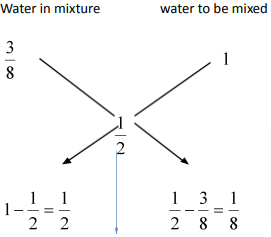
{total water after removing and then mixing}
Water in mixture : water to be mixed = 4:1
Mixture taken out = water replaced after that =![]()
TYPE 2: Replacing the mixture ‘n’ times.
Concept: If a vessel has ‘y’ units of mixture of ingredients ‘a’ and ‘b’. From this mixture ‘x’ unit is taken out and replaced by an equal amount of ingredient b. This process of taking out and replacing is repeated, say for ‘n’ times. Then,
Amount of ‘a’ left in the mixture = Total mixture x
Let us take an example to understand it.
Example 2: A container contains 60 litres of milk. From this container 6 litres of milk were taken out and replaced by water. This process was repeated further two times. The amount of milk left in the container is:
(1) 34.24 litres
(2) 39.64 litres
(3) 43.74 litres
(4) 47.6 litres
(SSC (10+2)Level Data EntryOperator & LDC Exam. 28.10.2012, 1st Sitting)
Solution: (3)
We know that,
Amount of ‘a’ left in the mixture = Total mixture x
Here the amount of milk left in the container is
![]()
= 43.74 litres.
TYPE 3: When the ratio of two or more mixtures is given.
Example 3: Two vessels A and B contain milk and water mixed in the ratio 4 : 3 and 2 : 3 respectively. The ratio in which these mixtures be mixed to form a new mixture containing half milk and half water is
(1) 7 : 5
(2) 6 : 5
(3) 5 : 6
(4) 4 : 3
(SSC (10+2)Level Data Entry Operator & LDC Exam. 28.10.2012, 1st Sitting)
Solution: (1)
Ratio of milk and water in final mixture = ![]() =1:1
=1:1
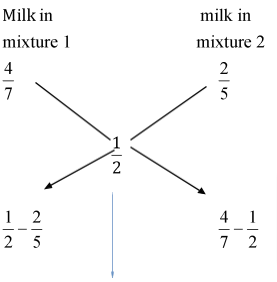
{amount of milk in ultimate mixture)

Therefore,the required ratio is:
=![]()
Example 4: The proportion of acid and water in three samples is 2:1,3:2 and 5 : 3 respectively. A mixture containing equal quantities of all three samples is made. The ratio of acid and water in the mixture is:
(1) 120 : 133
(2) 227 : 133
(3) 227 : 120
(4) 133 : 227
(SSC CAPFs SI & CISF ASI Exam. 23.06.2013)
Solution: (2)
Mixture 1 = acid : water =![]()
Mixture 2 = acid : water =![]()
Mixture 3 = acid : water =![]()
Required ratio:

Miscellaneous examples:
Example 5:In 50 gm alloy of gold and silver, the gold is 80% by weight. How much gold should be mixed to this alloy so that the weight of gold would become 95%?
(1) 200 gm
(2) 150 gm
(3) 50 gm
(4) 10 gm
(SSC Section Officer (Commercial Audit) Exam. 25.09.2005)
Solution: (2)
Initial quantity of gold
![]() gm
gm
Silver =50-40=10gm
Let the new mixture be x gm. As the new mixture has 95% gold, so it has 5% silver and actual quantity of silver is 10 gm. So, we have

Example 6: 15 litre of a mixture contains alcohol and water in the ratio 1 : 4. If 3 litre of water is mixed in it, the percentage of alcohol in the new mixture will be
(1) 15%
(2) 
(3) 17%
(4)
(SSC Graduate Level Tier-I Exam. 21.04.2013)
Solution: (2)
Alcohol =
Water = ![]()
When 3 litre of water is mixed then total qty of solution= 15 + 3 = 18 litre
Required percentage of alcohol =
Example 7: In what ratio must a grocer mix different tea, oneof Rs. 60 a kg, and other of Rs. 65 a kg, so that by selling the mixture at Rs. 68.20 a kg, he may gain 10%?
(1) 3 : 2
(2) 3 : 4
(3) 3 : 5
(4) 4 : 5
(SSC Combined Graduate LevelPrelim Exam. 08.02.2004 (First Sitting)
Solution: (1)
S.P. of 1 kg mixture= Rs. 68.20, gain = 10%
∴ C.P. of 1 kg mixture=![]() =
=![]() = Rs. 62
= Rs. 62
By the rule of alligation
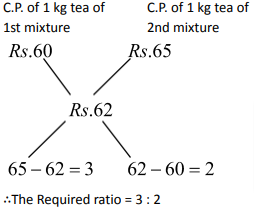
[Tip: It is advisable to go through the basics of profit and loss to solve such type of questions.]
With this we wind up this article on basics of Alligation & Mixtures. But before that, let us test what we have learnt by solving the exercise given below.
EXERCISE:
Question 1: Two alloys are both made up of copper and tin. The ratio of copper and tin in the first alloy is 1 : 3 and in the second alloy is 2 : 5. In what ratio should the two alloys be mixed to obtain a new alloy in which the ratio of tin and copper be 8 : 3 ?
(1) 3 : 5
(2) 4 : 7
(3) 3 : 8
(4) 5 : 11
(SSC 10+2 Data Entry Operator & LDC Exam. 27.10 2013, IInd Sitting)
Answer and Explanation
Solution: (2)
By rule of alligation,
Copper in Copper in
Alloy-I Alloy-II
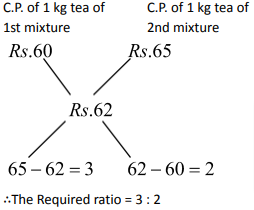
Question 2: 40 litres of a mixture of milk and water contains 10% of water, the water to be added, to make the water content 20% in the new mixture is:
(1) 6 litres
(2) 6.5 litres
(3) 5.5 litres
(4) 5 litres
(SSC Combined Graduate LevelPrelim Exam. 11.05.2003 (First Sitting)
Answer and Explanation
Solution: (4)
Water in 40 litres of mixture = 40 ×![]() = 4 litres
= 4 litres
Let the new mixture be of x litres.
Amount of milk is constant and is 40 – 4 = 36 litre. In the new mixture, the percentage of milk is 80%, so we have,

So, 45 – 40 = 5 litres of water are added.
Question 3: The ratio in which two sugar solutions of the concentrations 15% and 40% are to be mixed to get a solution of concentration 30% is
(1) 2 : 3
(2) 3 : 2
(3) 8 : 9
(4) 9 : 8
(SSC Combined Graduate LevelPrelim Exam. 27.07.2008 (Second Sitting)
Answer and Explanation
Solution: (1)
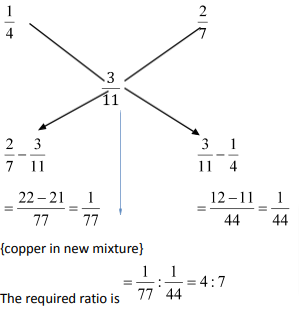
Alligations and Mixtures Questions: Problems on Alligations and Mixtures you should solve for competitive examination preparation
Welcome to this exercise on Problems on Alligations and Mixtures. In this exercise, we build on the basic concepts for Alligations and Mixtures. As you prepare for your competitive examinations, you will come











